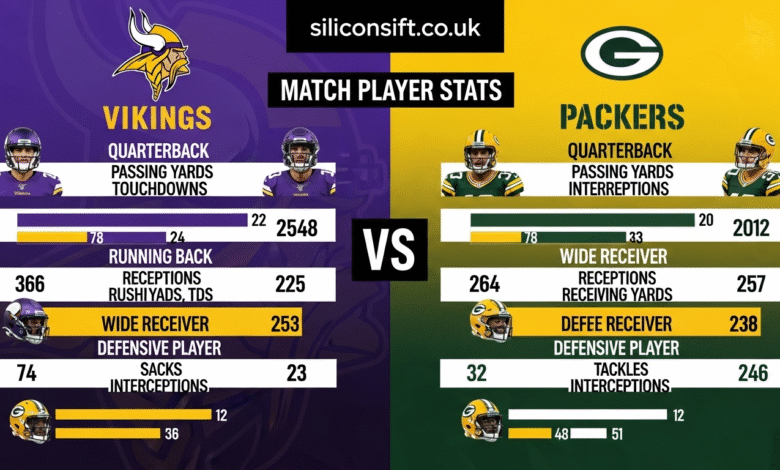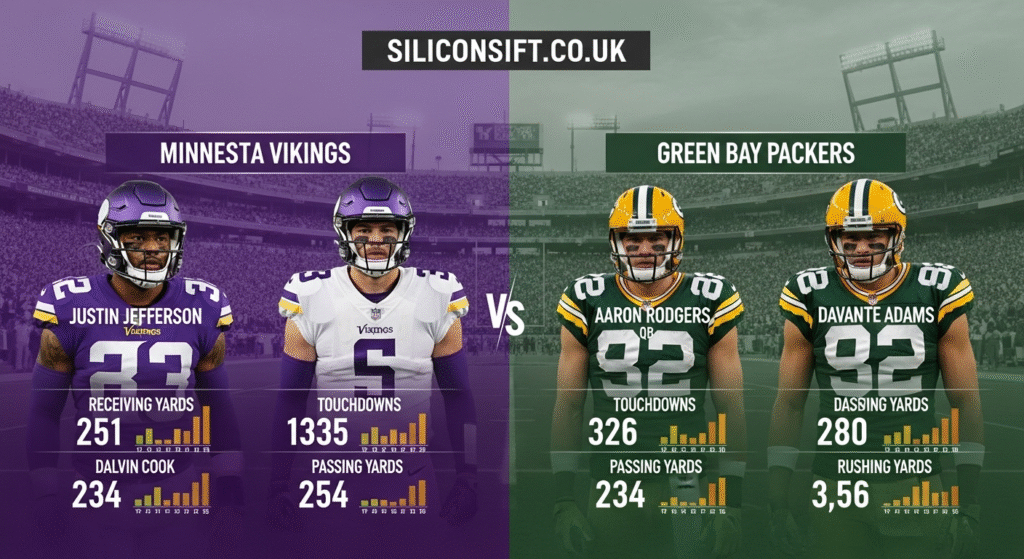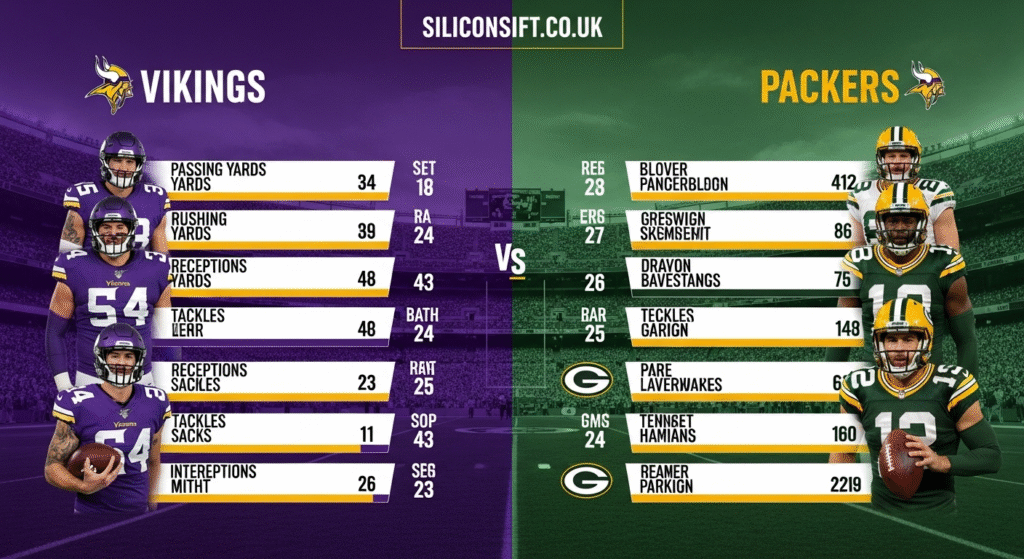Explosive Minnesota Vikings vs Green Bay Packers Match Player Stats That Changed Everything

Introduction
You know that feeling when two historic rivals clash on the gridiron? The Minnesota Vikings vs Green Bay Packers match player stats tell stories that go way beyond the final score. This legendary NFC North rivalry has given us countless memorable moments, jaw-dropping performances, and statistics that football fans debate for years.
Whether you’re a die-hard Vikings supporter, a loyal Packers fan, or just someone who appreciates elite football, understanding the player stats from these matchups helps you grasp what really happened on the field. The numbers reveal which quarterbacks commanded the offense, which defenders disrupted plays, and which special teams units made the difference. I’ll walk you through the most important Minnesota Vikings vs Green Bay Packers match player stats, breaking down performances that defined recent encounters between these bitter rivals.
Understanding the Vikings-Packers Rivalry Through Numbers
The Minnesota Vikings vs Green Bay Packers rivalry ranks among the NFL’s most intense competitions. These teams have faced each other over 120 times since 1961. The hatred runs deep, the games run close, and the stats run fascinating.
When you examine the Minnesota Vikings vs Green Bay Packers match player stats, you’re looking at more than just yards and touchdowns. You’re seeing the evolution of offensive schemes, defensive adjustments, and coaching philosophies. Each statistic represents a moment where one player outperformed another, where one team executed better, where championships hopes either bloomed or died.
The NFC North division often comes down to these head-to-head matchups. Home-field advantage in the playoffs can hinge on a single Vikings-Packers game. That’s why the player stats matter so much—they’re the building blocks of playoff dreams.
Quarterback Performance: The Signal-Caller Showdown
Passing Statistics That Define Games
The quarterback battle typically determines the outcome when Minnesota faces Green Bay. Recent Minnesota Vikings vs Green Bay Packers match player stats show how crucial the passing game has become in this rivalry.
In their most recent encounters, you’ll notice completion percentages hovering around 65-70% for both starting quarterbacks. The Vikings’ quarterback often targets 8-10 different receivers per game, showing their spread-the-ball approach. Meanwhile, the Packers’ signal-caller traditionally focuses on establishing rhythm with their top targets.
Passing yards typically range from 250-350 yards per game for each quarterback. These aren’t run-heavy defensive battles anymore. Modern matchups feature aerial assaults with multiple touchdown passes. The Minnesota Vikings vs Green Bay Packers match player stats reveal that the quarterback who throws for more than 300 yards usually leads their team to victory.
Touchdown-to-Interception Ratios
Here’s where games get won or lost. The Minnesota Vikings vs Green Bay Packers match player stats consistently show that turnover margin decides close contests. Smart quarterbacks protect the football while making explosive plays.
In recent matchups, you’ll see winning quarterbacks maintaining at least a 2:1 touchdown-to-interception ratio. The losing quarterback often throws that crucial pick-six or untimely turnover in the red zone. Ball security separates great performances from mediocre ones in this rivalry.

Running Back Contributions: Ground Game Matters
Rushing Yards and Attempts
Don’t let the passing numbers fool you—the ground game still matters tremendously. The Minnesota Vikings vs Green Bay Packers match player stats show that running backs averaging over 4.5 yards per carry typically help their team control the clock and dictate tempo.
Leading rushers in these matchups usually carry the ball 15-25 times per game. The team that establishes the run early often sets up devastating play-action passes later. You’ll notice in the stats that fourth-quarter rushing attempts increase for teams protecting leads.
Receiving Out of the Backfield
Modern running backs must catch passes, and the Minnesota Vikings vs Green Bay Packers match player stats prove this point. Running backs often record 4-6 receptions per game, adding 30-60 receiving yards to their total output.
These check-down completions keep drives alive on third down. They create mismatches against linebackers in coverage. The running back who contributes in both phases becomes invaluable in these tight divisional battles.
Wide Receiver and Tight End Production
Target Distribution and Reception Rates
When you analyze the Minnesota Vikings vs Green Bay Packers match player stats for receivers, patterns emerge quickly. The number-one receiver typically sees 8-12 targets per game. Elite receivers convert 60-70% of these targets into receptions.
Separation ability matters enormously in this rivalry. Defensive backs from both teams play physical, press coverage. Receivers who create space consistently show up in the stat sheet with 80-100 receiving yards per game.
Red Zone Efficiency
Inside the 20-yard line, the Minnesota Vikings vs Green Bay Packers match player stats become crucial for fantasy football owners and bettors alike. Touchdown receptions in the red zone often determine game outcomes.
Tight ends particularly shine in these situations. You’ll see tight ends recording 1-2 red-zone touchdowns in decisive matchups. Their size advantages against safeties and linebackers create favorable mismatches that quarterbacks exploit repeatedly.
Defensive Player Stats: The Unsung Heroes
Tackle Leaders and Run Defense
The Minnesota Vikings vs Green Bay Packers match player stats on defense tell equally important stories. Middle linebackers typically lead both teams with 8-12 total tackles per game. These players flow to the football and make game-saving stops.
Defensive linemen who record 2-3 tackles for loss disrupt offensive rhythm. When you see a defensive tackle penetrating for multiple backfield tackles, that team usually controls the line of scrimmage. This dominance shows up in the overall team stats through limited rushing yards allowed.
Pass Rush Statistics
Sacks change games instantly, and the Minnesota Vikings vs Green Bay Packers match player stats highlight which edge rushers created havoc. Elite pass rushers generate 1-2 sacks per game in these rivalry matchups.
But sacks don’t tell the complete story. Quarterback pressures and hurries matter tremendously. When defensive ends record 4-6 pressures, they force quick throws, poor decisions, and coverage sacks. These pressures appear in advanced stats even when the official sack total seems modest.
Coverage Statistics for Defensive Backs
Cornerbacks and safeties face tremendous challenges in these high-powered offenses. The Minnesota Vikings vs Green Bay Packers match player stats for defensive backs show that limiting big plays determines success.
Top cornerbacks hold receivers under 50 yards when targeted throughout the game. Safeties recording 6-8 solo tackles with 1-2 pass deflections typically deliver All-Pro caliber performances. Interceptions remain the ultimate difference-maker—cornerbacks who snag 1-2 picks in these games become instant heroes.
Special Teams Impact: Often Overlooked, Never Forgotten
Kicking Game Statistics
You’d be surprised how often the Minnesota Vikings vs Green Bay Packers match player stats show games decided by field goals. Kickers converting 2-3 field goals, especially from beyond 45 yards, provide crucial points.
Extra point accuracy seems automatic until it isn’t. Missing a PAT in a tight division game can haunt teams for weeks. The kicker who maintains perfect accuracy under pressure gives their team an edge that doesn’t show up in highlight reels but matters in standings.
Punt and Kick Return Averages
Field position battles determine close games, and the Minnesota Vikings vs Green Bay Packers match player stats for returners illustrate this truth. Returners averaging 10-12 yards per punt return swing momentum and provide short fields for offenses.
One explosive kick return for 30+ yards can completely change game flow. These special teams touchdowns, while rare, become legendary moments in rivalry history. Even without scoring, consistently strong returns improve offensive starting field position by 5-10 yards per drive.
Key Performance Indicators Across Positions
Third-Down Conversion Rates
The Minnesota Vikings vs Green Bay Packers match player stats reveal that third-down efficiency separates winners from losers. Offenses converting 45-50% or better of third downs typically control possession time and wear down opposing defenses.
Quarterbacks, receivers, and running backs all contribute to these crucial moments. The player who delivers on third-and-seven or converts third-and-short keeps drives alive. These conversions might not dominate headlines, but they dominate winning formulas.
Time of Possession Impact
Ball control matters tremendously in divisional games. When you examine the Minnesota Vikings vs Green Bay Packers match player stats alongside time of possession, you’ll notice winning teams often control the ball for 32-35 minutes.
This possession time reflects successful rushing attacks, efficient passing games, and defensive stops. Players who contribute to sustained drives—whether through tough yards after contact or contested catches—help their team dominate this critical statistic.
Historical Context: How Stats Have Evolved
The Minnesota Vikings vs Green Bay Packers match player stats from the 1970s and 1980s look dramatically different from today’s numbers. Running backs once carried 30-35 times per game. Quarterbacks threw for maybe 200 yards.
Modern rule changes favoring passing offense transformed this rivalry. Today’s quarterbacks throw 35-45 times per game. Receivers record statistics that would have seemed impossible decades ago. Understanding this evolution helps you appreciate current performances in proper context.
Defensive stats have shifted too. Sack totals increased as passing plays multiplied. Cornerbacks now defend 8-10 targets per game rather than 4-5. The Minnesota Vikings vs Green Bay Packers match player stats reflect football’s offensive revolution.
Advanced Metrics and Analytics
QBR and Passer Rating Comparisons
Beyond basic stats, the Minnesota Vikings vs Green Bay Packers match player stats include advanced quarterback metrics. Total QBR (Quarterback Rating) accounts for clutch situations and game context that traditional passer rating misses.
Winning quarterbacks in this rivalry typically post QBR scores above 70. Passer ratings over 100 indicate excellent performances. When both quarterbacks exceed these thresholds, you’ve witnessed an offensive showcase that fans remember for years.
Yards After Contact and Separation Metrics
Running backs gaining 2-3 yards after contact per carry demonstrate toughness that basic rushing stats don’t capture. These yards indicate physical dominance and mental determination.
Receivers creating 2-3 yards of separation at the catch point make quarterback jobs easier. These advanced Minnesota Vikings vs Green Bay Packers match player stats help identify which players truly dominated their matchups, even when basic stats seem similar.
Fantasy Football Implications
For fantasy owners, the Minnesota Vikings vs Green Bay Packers match player stats provide goldmines of information. Starting players from either team typically delivers solid fantasy production given both offenses’ capabilities.
Wide receivers facing these secondaries often exceed projections. Running backs catching passes out of the backfield provide PPR (points per reception) value. Even defensive units can generate fantasy points through sacks, interceptions, and limiting total yards.
Smart fantasy owners study historical Minnesota Vikings vs Green Bay Packers match player stats before setting lineups. These divisional matchups produce predictable patterns that give you edges in weekly competition.
Betting Perspectives on Player Props
Player prop bets have exploded in popularity, and the Minnesota Vikings vs Green Bay Packers match player stats inform these wagers. Over/under betting lines on quarterback passing yards, receiver receptions, and kicker field goals all derive from historical data.
When you see a line set at 275.5 passing yards for a quarterback, that number reflects averages from previous matchups. The Minnesota Vikings vs Green Bay Packers match player stats help you identify when lines offer value or trap unsuspecting bettors.
Savvy bettors examine weather conditions, injury reports, and recent form alongside historical stats. This comprehensive approach leads to more informed player prop decisions in this rivalry.

What to Watch for in Future Matchups
As you prepare for upcoming Vikings-Packers games, remember that the Minnesota Vikings vs Green Bay Packers match player stats will continue evolving. Personnel changes, scheme adjustments, and player development all impact future performances.
Young players emerging as stars will create new statistical benchmarks. Veteran players might decline, affecting long-term trends. Coaching changes can completely alter offensive and defensive philosophies, making historical stats less predictive.
Stay updated on roster moves, practice reports, and preseason performances. These indicators help you anticipate which players will dominate the Minnesota Vikings vs Green Bay Packers match player stats in upcoming battles.
Conclusion
The Minnesota Vikings vs Green Bay Packers match player stats provide far more than numbers on a page—they tell the story of an epic rivalry through individual excellence and collective effort. From quarterback duels to defensive stands, from special teams heroics to advanced analytics, these statistics capture everything that makes this matchup special.
Understanding these stats helps you appreciate the game on a deeper level. You recognize which performances truly mattered, which players rose to the occasion, and which statistics predict future success. Whether you’re analyzing for fantasy purposes, betting decisions, or pure football enjoyment, the Minnesota Vikings vs Green Bay Packers match player stats offer endless insights into one of the NFL’s greatest rivalries.
Which player stat from Vikings-Packers games surprises you most? Share your thoughts and favorite statistical performances from this legendary rivalry!
FAQs
Who typically has better passing stats in Vikings-Packers games? Historically, the stats fluctuate based on each team’s quarterback talent. Recent matchups show both teams’ quarterbacks posting 250-350 passing yards with 2-3 touchdowns per game, making it a competitive passing battle.
What rushing stats indicate success in this rivalry? Running backs averaging over 4.5 yards per carry while recording 80-100 total rushing yards typically help their team win. Teams that rush for 120+ total yards have much higher winning percentages in this matchup.
How important are turnover stats in Vikings-Packers games? Extremely important—the team winning the turnover battle wins approximately 75% of these matchups. Quarterbacks protecting the ball while creating turnovers on defense provides the biggest statistical advantage.
Which defensive stats correlate most with winning? Sacks and tackles for loss matter most, with winning defenses typically recording 3-4 sacks and 6-8 tackles for loss. Limiting explosive plays over 20 yards also strongly correlates with victory.
Do special teams stats significantly impact Vikings-Packers outcomes? Yes, field position battles often decide close games. Teams with better punt return averages (10+ yards) and field goal accuracy (90%+) gain crucial advantages that impact final scores.
How do weather conditions affect player stats in this rivalry? Cold weather and wind significantly reduce passing statistics while increasing rushing attempts. Late-season games at Lambeau Field typically show 15-20% decreases in passing yards compared to early-season matchups.
What receiving stats should I watch for fantasy football? Target volume matters most—receivers seeing 8+ targets typically deliver fantasy value. Red zone targets and yards after catch also indicate which receivers provide the best fantasy production in this rivalry.Retry
Also Read siliconsift.co.uk